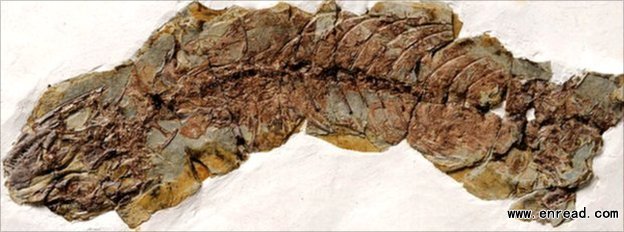科学家首次发现怀孕蜥蜴化石
A 120-million-year-old fossil is the oldest pregnant lizard ever discovered, according to scientists.
根据科学家研究显示,一具有1.2亿年历史的化石是迄今发现的最古老的怀孕蜥蜴化石。

The lizard was just days from giving birth when it died and was buried
Researchers from University College London, who studied the fossil, say it was just days from giving birth when it died and was buried during the Cretaceous period.
The team reports the findings in the journal Naturwissenschaften.
The fossil is especially interesting to scientists because it is a reptile(爬行动物) that produced live young rather than laying eggs.
Only 20% of living lizards and snakes produce live young, and this shows it is an ancient, if unusual, trait.
"I didn't think much of the fossil when I first saw it," said Prof Susan Evans, joint lead author of the paper, from University College London.
But when her colleague, Yuan Wang, from the Chinese Academy of Sciences, examined the fossil he spotted the tiny remains of at least 15 almost fully developed embryos inside it.
"Sure enough, when I examined it under the microscope, I could see all these little babies," Prof Evans recalled.
The fossil is so well preserved that the minuscule(极小的) teeth of the developing young are visible on very close inspection.
"This specimen is the oldest pregnant lizard we have seen," said Prof Evans.
"It implies physiological adaptations, like adequate blood supply to the embryos and very thin shells - or no shells at all - to allow oxygen supply, evolved very early on."
Up until now the fossil records only contained examples of marine lizards giving birth to live young.
Scientists thought that, in extinct reptiles, live birth was restricted to aquatic(水生的) species, such as marine ichthyosaurs(亲戚,相关物) . These creatures would have been able to move through water with relative ease, even when heavily pregnant.